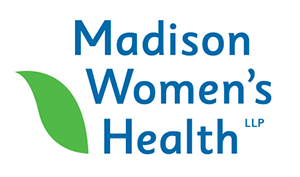If you’re worried about breastfeeding, you’re not alone. Feelings of inadequacy or fearing that it will be too difficult are very common among new moms. But the good news is there is a lot of help and support available to you!
At Madison Women’s Health, we will share the evidence that demonstrates the benefits of breastfeeding, but we ultimately support the decision of the mother and family. We will do whatever we can to help you be successful in feeding your baby.
One of the best ways to prepare for breastfeeding is to educate yourself before your baby arrives. My hope is that this blog post will address the concerns you may have so that you can feel confident when your little one arrives!
Answers to New Moms’ Top Concerns About Breastfeeding:
What if I don’t produce enough milk?
As early as 24 weeks, some women begin to notice colostrum in their breasts. It will keep being produced until your body makes regular breast milk. Colostrum is very nutrient-rich “pre-milk” that is made for your newborn baby and contains antibodies that protect your baby for life. It may not seem like a lot, but it is just what your baby needs at birth. Colostrum is all about quality, not quantity.
(While you’re in the hospital, you can ask your doctor or nurse to help you with breast massage or hand expression to show you that the milk is there.)
The appearance and amount of colostrum differs for every woman. For some, it is clear and thin. For others, it can have color that ranges from yellows to greens and is a thicker consistency.
About 3-5 days after you deliver your baby, your body will begin producing the more mature milk, which is generally whiter and creamier. The more frequently that your milk is removed, whether from breastfeeding or pumping, the more will be produced. This is why it’s ideal to give your baby frequent attempts to nurse, about every 2-3 hours.
If you cannot produce breast milk, donated breast milk is also an option. To get donor milk in the Madison area, contact the Mother’s Milk Alliance or the Mother’s Milk Bank of Western Great Lakes. The milk from these milk banks is free, but a donation to cover the costs of donor health screens is appreciated. You could also contact the Hoey Apothecary pharmacy to purchase pasteurized breast milk.
My friends tell me breastfeeding was hard. What if I can’t handle it?
- Sometimes breastfeeding can be challenging at first, that’s true. But like every new thing that you learn, the more you try and have patience with yourself (and your baby!), and the more you ask for help, the easier it can become.Find comfort knowing that you’re never alone in your journey! Madison Women’s Health patients deliver their babies in the hospital, so they may have labor nurses, postpartum support, lactation consultants and even doulas. All of these people are here to help you and support you in your decision.Decrease your anxiety about breastfeeding by reading about it, taking classes, and learning as much as you can. We offer a postpartum support group so you can learn from other womens’ experiences. You can also reach out to the local lactation consultant team at Meriter.The most important thing is to ask for help early on. Don’t wait until you feel hopeless. Just give us a call at (608) 729-6300, and we’ll make a plan to help you.
Other Breastfeeding resources:
- Kellymom.com — an evidence-based website about breastfeeding that’s very useful before and during breastfeeding.
- LLLUSA.org — The La Leche League website includes links to local support groups.
- Various breastfeeding apps — Time can blend together, especially in the first few days after you give birth. An app can help you keep track of when you fed your baby last, for how long, and on which side. This can help reduce your stress so you don’t need to keep track of so many details.
Will I have any support, or will I be the only one up with a crying baby?
Many times, your partner wants to help but doesn’t know what to do. When I go on my postpartum rounds at the hospital, I make sure to include your partner in our conversation about breastfeeding.
Your partner can check out the baby’s latch onto your nipple and can help you arrange a pillow to support your comfort. Or your partner can help with things like keeping track of when you fed your baby last and on which side. If you supplement with formula, your partner can get the bottles ready. And of course, your partner can also be the designated bottle washer!
Will breastfeeding ruin my breasts permanently?
Your breasts won’t be exactly the same as they were before pregnancy, whether you breastfeed or not. Be willing to embrace these changes and love the body that has created a new life! Wearing supportive bras while pregnant and breastfeeding will be more comfortable for you and may help to alleviate some of the stress on your breast tissue.
What if I have inverted or flat nipples?
Instead of sticking outward, inverted or flat nipples lie flat against the areola. About 2-10% of women have inverted or flat nipples. A baby can still breastfeed on them, but it might take a little extra work to help your baby draw the nipple into their mouth. Some women find that using a suction cup on the nipple before breastfeeding can help the baby latch on more quickly.
Is it possible to breastfeed twins or multiples?
You can nurse twins (or two babies) at the same time. Using nursing pillows for twins can make it easier to hold your babies in the right position. If nursing at the same time doesn’t work for you and your babies, that’s ok! Your babies are individuals and may like to nurse differently, or they may simply be hungry at different times.
It’s important to continue switching which breast you nurse from. You can also supplement with bottle feeding, having your partner feed one while you nurse the other. Be patient and flexible with yourself and your little ones.
Do I need to keep to a strict breastfeeding schedule?
Every woman’s breasts have different storage capacity for milk, which isn’t related to breast size. That’s why it’s important to listen to your body and baby’s cues for how often to nurse. A general rule of thumb is to nurse newborns every 2-4 hours.
Sometimes, it’s ok to just throw the clock away and simply nurse when your baby is hungry. Don’t wait until they are “hangry” — when they’re crying and frustrated. It’s harder for them to latch on and they’re more likely to gulp down air and experience gas pains.
Can I bottle feed AND breastfeed?
You may wonder if you’ll ever be able to have someone else help feed your baby or if you’ll be the only one doing all the work. Bottle feeding—either pumped breast milk or formula—is definitely possible and could be a good way to give yourself a much needed break. If you interchange between bottles and breast very early on, “nipple confusion” could happen, so I recommend waiting a few weeks to introduce a bottle.
Some babies simply don’t want a bottle — they just want mom. To help them make the switch, have someone else feed the baby in another room. It may take a few tries, but that’s ok. Try to remove distractions and simulate your baby’s favorite nursing position while holding the bottle.
I had a hard time breastfeeding my first baby. Will it be hard to breastfeed my second baby, too?
When breastfeeding your first baby was challenging, it’s very common to worry that breastfeeding the second one could also be hard. But one good thing to remember is this second time, at least one of you has done it before! Simply start trying what worked well the first time. Involve your pediatrician even earlier into the process.
It’s also important to remember that your second baby may not feel as hungry in their first 24 hours, and therefore may not be as interested in breastfeeding. This is normal! In vaginal births, the second baby is often pushed out more quickly than the first. There is less time to squish out the amniotic fluid from their tummies. Keep offering your breast, but don’t be discouraged if it takes a little longer for your second baby to get that first good latch.

Common Breastfeeding Problems for First-Time Moms
Sore nipples
Sore nipples are often caused by several on/off attempts to fix your baby’s latch. You can use lanolin, olive oil, or nipple butter between feedings to moisturize your nipples. I also recommend letting your nipples air dry between feedings. Generally, sore nipples don’t last more than a week or two.
Engorgement
Engorged breasts can throb and feel swollen, hot or lumpy due to all the milk being produced as well as the extra lymph fluids and blood that flow to the breast tissue. It typically happens when a baby isn’t feeding frequently enough. Not only are engorged breasts painful, they make it harder for the baby to latch on because they are harder and flatten the nipple.
If the milk stays in one spot for too long, that’s a prime environment for bacteria to grow. (This is also why we recommend switching breasts and positions when feeding your baby.)
To relieve the pressure and to help reduce the swelling, empty your breasts by hand just a little. Use some heat and gently massage your breasts. You can also take some ibuprofen or Tylenol to help with the pain. Be aware that there is a balance, though! The more you empty your breasts, the more milk your body will make.
Yeast infections
Some women get yeast infections in the crease of skin under the breasts or on their nipples. Yeast takes advantage of warm, wet areas to grow. If milk leaks from your breasts and you’re wearing a bra that doesn’t fit right, or it’s the third day in a row you’ve worn the same sports bra, you’re creating an environment for the yeast to grow.
To prevent a yeast infection from starting, keep the skin around your breasts dry. Try drying with a hair dryer after your shower. Wash your tanks, bras and shirts in hot water.
To treat the yeast infection, you can apply an over-the-counter or prescription antifungal ointment to the skin.
Clogged Duct
A clogged duct can feel like a painful lump in your breast that comes on gradually. It’s an area of the breast tissue where the milk is blocked. It typically only affects one breast at a time. It can be caused by inadequate feeding, using the same position all the time, or by pressure on a duct from something like a diaper bag strap. You can relieve the pressure of a clogged duct with gentle heat, breast massage, or pumping. Nurse in the “dangle position” to allow gravity to help the milk flow to your nipple.
Mastitis
Mastitis is an inflammation of the breast tissue or ducts. It is painful and often accompanied by red marks that streak out from the affected area. Other symptoms include chills, aches, and a fever over 101℉.
If your breasts aren’t being emptied after each feeding, one reason could be that your baby hasn’t latched on correctly and is using your breast more as a pacifier instead of for eating.
Contact your provider if your symptoms last more than 24 hours.
What to do if your baby has trouble latching on
When your baby has trouble latching on during breastfeeding, it can cause discomfort for both of you. Your baby gets frustrated and cries as she sucks and doesn’t get enough milk, then she gulps down more air as she tries to feed. That extra air leads to painful gassiness. When she doesn’t empty your breasts at each feeding, it can cause problems for you like sore nipples, breast engorgement, clogged ducts or even mastitis.
Working with a lactation consultant can help. A lactation consultant (LC) is a nurse who has taken additional training and passed a rigorous certification exam. During a consult, the LC will watch a feeding and pay special attention to the latch so you can learn what a good latch feels like. You’ll learn how to handle the nipple and hold your baby to get the most breast tissue in your baby’s mouth. You’ll also learn some good positions for breastfeeding.
If latching problems continue, be sure to involve your family practice doctor who could help you determine if it’s a tongue-tie situation.
Good breastfeeding positions
It helps to use a variety of positions when breastfeeding your baby. Holding your baby at a different angle could help to empty your breast more fully and also help to relieve nipple soreness. Some positions also make it easier to see how your baby is latching on to your breast. Your nurse can help you try these positions, or you could also search YouTube for videos to help you learn about different options. I’ve included some links below to get you started.
These are the most common breastfeeding positions that we teach women to use:
- Football: This is the easiest position to learn first because you can see the baby’s top and bottom lip. Essentially, you’ll hold your baby like you’d hold a football! https://www.youtube.com/watch?v=XQxC5GTqAUU
- Cradle: This is one of the most common positions. You’ll cradle your baby’s head close to your breast, supporting your baby with your arm along their back and neck. https://youtu.be/z3Nav5DXj5s
- Cross Cradle: Similar to the cradle position, but use your opposite arm to support your baby. Use your hand closest your breast to support and shape your breast as needed. https://www.youtube.com/watch?v=MRz8Bozv4nw
- Side lying: This position is especially helpful if sitting is uncomfortable for you. Lie on your side, facing your baby, and line your baby’s mouth up with your nipple. https://www.youtube.com/watch?v=IHhwxEB6DEw&list=PLZAetHSBnOoHujidgcCzFwoSGd2YPXYp1&index=7&t=0s
- Dangling: If you have blocked ducts, try using this position. Gravity helps the milk to flow to the nipple as you hold your breast over your baby’s mouth. https://youtu.be/MsVI4q0ksHY
Deciding When and How to Wean
Weaning your baby from breastfeeding is a very personal and individual decision to make. It varies by family and by baby. Some women breastfeed for all of the baby’s first year and even into their second year or longer. Others stop after 6 months or less. It’s important to do what works best for you, your baby and your family.
Night weaning could help you get more sleep at night and encourage your baby to develop healthy eating habits. To get started with night weaning, you could nurse more often during the day so your baby is less hungry at night.
Some babies wean on their own. This is called baby-led weaning. When you begin introducing solid foods at about 4-6 months, your baby may be less interested in breastfeeding or may need to nurse less often. If you get pregnant while you are still nursing (yes, it happens!) the flavor of your milk may change and your baby might refuse it. It is still possible to continue breastfeeding your toddler even when you are breastfeeding your newborn. This is called tandem breastfeeding.
If your baby still wants to breastfeed, but you are done, that’s ok, too. The important thing is to remember that weaning is a gradual process. You can start weaning by adding solid foods to the baby’ diet, offering a sippy cup with water, and taking out one feeding a day until you’re only nursing once in the morning and once at night.
One of the risks to weaning very early is that your resulting change in hormones could lead to postpartum depression. Please reach out to your provider if you are having trouble with your decision to wean. We would love to help you with your postpartum issues.
Tips for Pumping Breast Milk
For many women, going back to work signals the start of weaning or else a switch from breastfeeding to bottle feeding. Pumping your breast milk will help you continue to provide the nutritional and immunological benefits of breast milk. Your partner will also be able to help out with feeding the baby with a bottle, which can actually be beneficial for their bond.
When you’re pumping at work, try to mimic the schedule and routine you set up at home. Talk to your boss or manager ahead of time so you can have a quiet space to go and pump about every 3-4 hours.
- Be sure to thoroughly clean all pump parts so no bacteria grows in them.
- Label the bags of breastmilk with the date and/or your baby’s age. If you end up pumping more than your baby will take with a bottle, you can freeze the milk for later or donate it to a milk bank.
- Recruit your partner to wash and prepare bags and bottles.
- Recommended Pumps: the Medela and the Spectra are hospital grade breast pumps. You can find adapters to use Medela parts on Spectra pumps. Many health insurance plans cover specific brands of breast pumps, so check with your insurance before purchasing a breast pump.
- Discrete pump: the Willow is a quieter pump that you can tuck in your bra and wear at work. It doesn’t produce as much suction, but could be a solution if you’re not able to find a private place to pump.
The Most Important Breastfeeding Tip: Ask for Help!
The most important advice I give to every new mom-to-be is to read ahead, educate yourself, and be willing to ask for help. Successful breastfeeding is all about the positioning, and there’s no way a first time mom can know everything! We’re here to help you in any way that we can.
Consider joining our postpartum support group. We talk about all things breastfeeding and more!
 Dr. Sarah Yanke has been providing healthcare to women in Madison since 2010, specializing in high and low-risk obstetrics, contraception, management of abnormal uterine bleeding, and minimally invasive surgical techniques. She is a Board Certified Fellow of the American College of Obstetrics and Gynecology.
Dr. Sarah Yanke has been providing healthcare to women in Madison since 2010, specializing in high and low-risk obstetrics, contraception, management of abnormal uterine bleeding, and minimally invasive surgical techniques. She is a Board Certified Fellow of the American College of Obstetrics and Gynecology.



